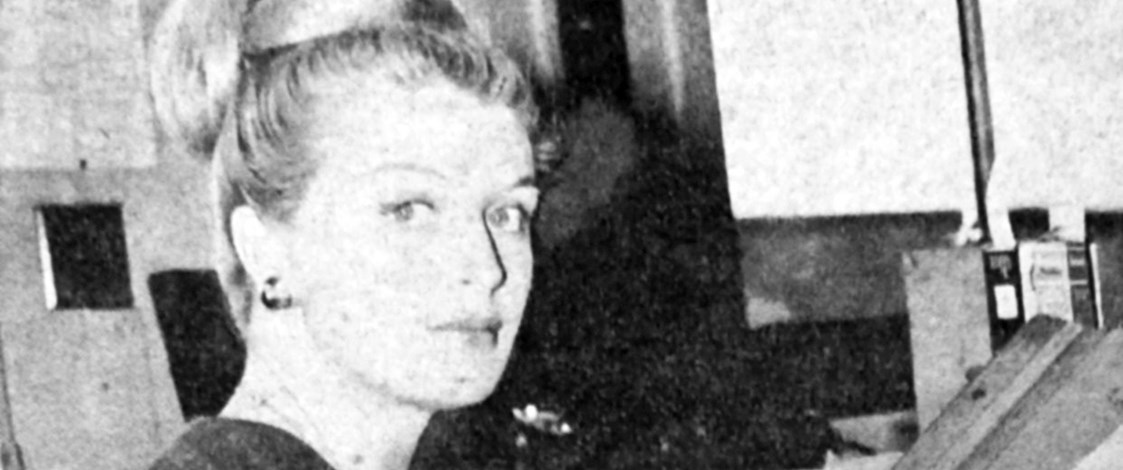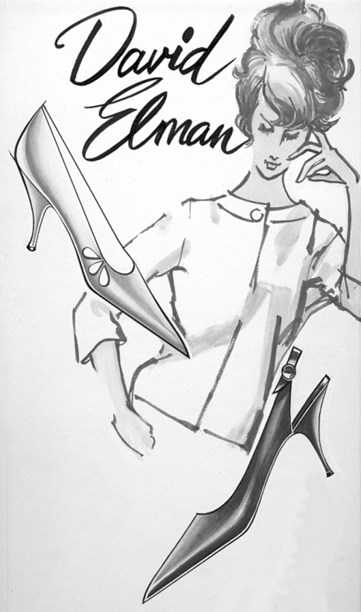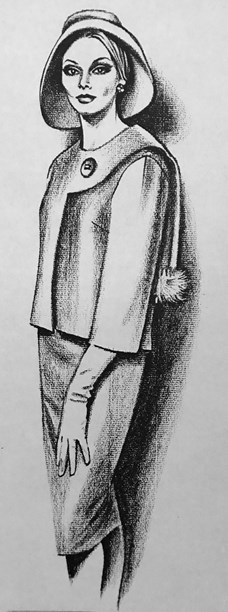Stories
Margaret Halcrow-Cross
1938-2015

One of the most prolific fashion commercial artists in New Zealand of her time, Margaret Halcrow-Cross was her own best advertisement. She loved wearing the latest fashions as much as she enjoyed drawing them. Cool, reserved and well-groomed, she had something of the Hitchcock blonde about her. The ladylike looks of the 1950s, the era when her career began, suited her to perfection.
As fashion moved on, she updated her look, in later years cultivating a more bohemian, artistic image. Fitted blue jeans tucked into high boots, artisan-style jewellery and a rainbow-coloured bandana wrapped around her forehead became her uniform.

Margaret Halcrow-Cross, late 1960s. Image © Christian Chapman.
An expert sewer, she made most of her own clothes, laying the fabric on the floor and cutting out garment components without the use of patterns. "If there was a wedding or special occasion, she would whip up a complete outfit a few days beforehand," says her son Christian Chapman, "and everybody would comment that she should go into business selling her creations."
Born in Auckland in 1938, Margaret, who was of Norwegian descent, lived in Dunedin from the age of three. She completed her secondary schooling at the King Edward Technical College (1953 – 1956) where she took art as her main subject. A fellow student remembers her as a natural talent, quiet, unassuming and engrossed in her art. "While most of us adopted a rather cavalier attitude toward our art studies, Margaret took them very seriously. She was an exceptional student and, as it turned out, one of only about three students from our class of 25 to gain a Diploma of Fine Arts Prelim." This would have ensured her a place at Canterbury University’s Ilam School of Fine Arts but lack of funds prevented further study. Instead, she pursued a career in commercial art or, as it is known today, graphic art.
Margaret’s first job at Argent Packaging in Dunedin, designing confectionery and biscuit packaging and tins, possibly for Aulsebrooks or Cadburys, was followed by a position drawing advertisements for shoe retailer W Harris & Co. In 1960, she was appointed head of advertising at The DIC, one of Dunedin’s most fashion-forward department stores. Her role involved illustrating the merchandise, choosing typefaces and doing the ad layouts, a big responsibility for one so young.

Original artwork for David Elman shoe advertisement, 1950s. Image © Christian Chapman.
Like many other New Zealand fashion artists working in advertising at that time, Margaret looked to the New York Times for inspiration. Bergdorf Goodman, Bloomingdales, Lord & Taylor, all the big New York department stores had their own distinctive style of fashion drawing. Margaret’s favourite was an artist from Gimbels, whose technique, featuring the use of a type of crayon on textured paper, she much admired.

Original artwork for classic 1950s suit. Image © Christian Chapman.
In 1963, Margaret moved to Wellington. Before joining the art department as a fashion artist at Ilott Advertising, one of the country’s oldest established advertising agencies, she illustrated ads for Hannah’s shoes.
Throughout the 1960s Margaret Halcrow Cross’s artwork was mostly black and white with the occasional foray into colour. Image © Christian Chapman.
In 1967, she and fellow graphic artist Doug Chapman, who she married the same year, shifted to Christchurch where they established themselves as freelance artists. When Paula Ryan, later co-founder of Fashion Quarterly magazine, went to live in London in 1971, the couple bought her studio Paula Ryan Graphic Design and renamed it Doug And Margaret Chapman Design.
Lichfield was a Christchurch firm (named after the location, Lichfield Street) that manufactured women’s clothing and men’s shirts. Artwork by Margaret Halcrow-Cross, 1970s. Image © Christian Chapman.
After their marriage ended in 1977, the Chapmans also terminated their working relationship and Margaret continued freelancing independently from a studio in her Sumner home, an old cottage that once belonged to the poet Denis Glover.
As Fifties’ hauteur gave way to the Biba-esque dollybird, the flower child and the bold-shouldered glamazon, Margaret’s illustrative style also evolved. How she adapted to the changes can be seen in the hundreds of advertisements she created for shoe retailers, clothing companies, department stores (Farmers, The DIC, Hays, later Haywrights, and Beaths) and smaller establishments such as the landmark Christchurch fashion store Quinns of Merivale.
Store advertising made up a large amount of Margaret Halcrow-Cross’s output. Image © Christian Chapman.
Margaret was also an accomplished book illustrator, print-maker and painter. She exhibited in various Christchurch galleries and her detailed depictions of organic subjects and the natural environment were purchased by local and international art collectors alike.
One year, during the Garden City Festival of Flowers, she was commissioned to produce a large painting, to hang in the entrance of Christchurch Cathedral, to complement a floral carpet designed by a fellow artist. Embroidery, quilting and patchwork were among her other interests.
In 1975, Margaret entered the New Zealand Post Office stamp design competition, which attracted 267 entries, and won. She subsequently created designs for several sets of Christmas stamps, Health stamps and First Day covers.
Desirous of a more secluded lifestyle closer to nature, she moved in 2003 to a remote and romantic property in Pigeon Bay on Banks Peninsula. Here she tended a large flower garden and continued to paint, exhibiting occasionally at the Powerhouse Gallery in Akaroa.
In 2012, Margaret Halcrow-Cross returned to Dunedin and, until her death in 2015, lived in comparative isolation in Warrington, a tiny seaside hamlet north of the city. Christian Chapman, a successful artist himself who lives beach-side in New South Wales, says of his mother: "Her talent was unbelievable. Most of my inspiration to create art, I attribute to her."
Margaret maintained a studio until the end of her life. Filled with artist’s paraphernalia –pencils, paints, shelves stacked with art paper, old picture frames, brushes in a turquoise ceramic pot – it also housed the paint-splattered tilting art table, fitted with drawers, on which she produced her fashion drawings and other artworks for over 30 years.
Text by Cecilie Geary.
Last published February 2018.